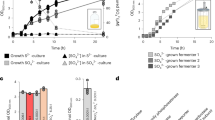Abstract
Methane is a potent greenhouse gas that is produced in significant quantities by aerobic marine organisms1. These bacteria apparently catalyse the formation of methane through the cleavage of the highly unreactive carbon–phosphorus bond in methyl phosphonate (MPn), but the biological or terrestrial source of this compound is unclear2. However, the ocean-dwelling bacterium Nitrosopumilus maritimus catalyses the biosynthesis of MPn from 2-hydroxyethyl phosphonate3 and the bacterial C–P lyase complex is known to convert MPn to methane4,5,6,7. In addition to MPn, the bacterial C–P lyase complex catalyses C–P bond cleavage of many alkyl phosphonates when the environmental concentration of phosphate is low4,5,6,7. PhnJ from the C–P lyase complex catalyses an unprecedented C–P bond cleavage reaction of ribose-1-phosphonate-5-phosphate to methane and ribose-1,2-cyclic-phosphate-5-phosphate. This reaction requires a redox-active [4Fe–4S]-cluster and S-adenosyl-l-methionine, which is reductively cleaved to l-methionine and 5′-deoxyadenosine8. Here we show that PhnJ is a novel radical S-adenosyl-l-methionine enzyme that catalyses C–P bond cleavage through the initial formation of a 5′-deoxyadenosyl radical and two protein-based radicals localized at Gly 32 and Cys 272. During this transformation, the pro-R hydrogen from Gly 32 is transferred to the 5′-deoxyadenosyl radical to form 5′-deoxyadenosine and the pro-S hydrogen is transferred to the radical intermediate that ultimately generates methane. A comprehensive reaction mechanism is proposed for cleavage of the C–P bond by the C–P lyase complex that uses a covalent thiophosphate intermediate for methane and phosphate formation.
This is a preview of subscription content, access via your institution
Access options
Subscribe to this journal
Receive 51 print issues and online access
$199.00 per year
only $3.90 per issue
Buy this article
- Purchase on Springer Link
- Instant access to full article PDF
Prices may be subject to local taxes which are calculated during checkout





Similar content being viewed by others
References
Reeburgh, W. S. Ocean methane biogeochemistry. Chem. Rev. 107, 486–513 (2007)
Karl, D. M. et al. Aerobic production of methane in the sea. Nature Geosci. 1, 473–478 (2008)
Metcalf, W. W. et al. Synthesis of methylphosphonic acid by marine microbes: a source of methane in the aerobic ocean. Science 337, 1104–1107 (2012)
Wackett, L. P., Shames, S. L., Venditti, C. P. & Walsh, C. T. Bacterial carbon-phosphorus lyase: production, rates and regulation of phosphonic and phosphinic acid metabolism. J. Bacteriol. 169, 710–717 (1987)
Frost, J. W., Loo, S., Cordiero, M. & Li, D. Radical-based dephosphorylation and organophosphonate biodegradation. J. Am. Chem. Soc. 109, 2166–2171 (1987)
Wackett, L. P., Wanner, B. L., Venditti, C. P. & Walsh, C. T. Involvement of the phosphate regulon and the psiD locus in the carbon-phosphorus lyase activity of Escherichia coli K-12. J. Bacteriol. 169, 1753–1756 (1987)
Metcalf, W. W. & Wanner, B. L. Mutational analysis of an Escherichia coli fourteen-gene operon for phosphonate degradation using TnphoA’ elements. J. Bacteriol. 175, 3430–3442 (1993)
Kamat, S. S., Williams, H. J. & Raushel, F. M. Intermediates in the transformation of phosphonates to phosphate by bacteria. Nature 480, 570–573 (2011)
Cicchillo, R. M. et al. Escherichia coli lipoyl synthase binds two distinct [4Fe-4S] clusters per polypeptide. Biochemistry 43, 11770–11781 (2004)
Cicchillo, R. M. et al. Escherichia coli quinolinate synthetase does indeed harbor a [4Fe-4S] cluster. J. Am. Chem. Soc. 127, 7310–7311 (2005)
McGlynn, S. E. et al. Identification and characterization of a novel member of the radical AdoMet enzyme superfamily and implications for the biosynthesis of the Hmd hydrogenase active site cofactor. J. Bacteriol. 192, 595–598 (2010)
Zhang, Y. et al. Diphthamide biosynthesis requires an organic radical generated by an iron-sulphur enzyme. Nature 465, 891–896 (2010)
Sofia, H. J., Chen, G., Hetzler, B. G., Reyes-Spindola, J. F. & Miller, N. E. Radical SAM, a novel superfamily linking unresolved steps in familiar biosynthetic pathways with radical mechanisms: functional characterization using new analysis and information visual methods. Nucleic Acids Res. 29, 1097–1106 (2001)
Frey, P. A., Hegeman, A. D. & Ruzicka, F. J. The radical SAM superfamily. Crit. Rev. Biochem. Mol. Biol. 43, 63–88 (2008)
Booker, S. J. & Grove, T. L. Mechanistic and functional versatility of radical SAM enzymes. F1000 Biol. Rep. 2, 52 (2010)
Eklund, H. & Fontecave, M. Glycyl radical enzymes: a conservative structural basis for radicals. Structure 7, R257–R262 (1999)
Logan, D. T., Andersson, J., Sjoberg, B. M. & Nordlund, P. A glycyl radical site in the crystal structure of a class III ribonucleotide reductase. Science 283, 1499–1504 (1999)
Becker, A. et al. Structure and mechanism of the glycyl radical enzyme pyruvate formate-lyase. Nature Struct. Biol. 6, 969–975 (1999)
Vey, J. L. et al. Structural basis for glycyl radical formation by pyruvate formate-lyase activating enzyme. Proc. Natl Acad. Sci. USA 105, 16137–16141 (2008)
Ghanem, E., Li, Y., Xu, C. & Raushel, F. M. Characterization of a phosphodiesterase capable of hydrolyzing EA 2192, the most toxic degradation product of the nerve agent VX. Biochemistry 46, 9032–9040 (2007)
Frey, M., Rothe, M., Wagner, A. F. V. & Knappe, J. Adenosyl methionine-dependent synthesis of the glycyl radical in pyruvate formate-lyase by abstraction of the glycine C-2 pro-S hydrogen atom. J. Biol. Chem. 269, 12432–12437 (1994)
Licht, S., Garfen, G. J. & Stubbe, J. Thiyl radicals in ribonucleotide reductases. Science 271, 477–481 (1996)
Acknowledgements
We thank D. Barondeau for use of the anaerobic chamber, R. Stipanovic for use of the gas chromatography mass spectrometer, A. Mehta and T. Begley for use of the liquid chromatography mass spectrometer, and C. Hilty for use of the 31P-NMR spectrometer. We thank P. A. Lindahl for help with the EPR measurements (GM084266). This work was supported by the Robert A. Welch Foundation (A-840).
Author information
Authors and Affiliations
Contributions
S.S.K., H.J.W. and F.M.R. designed the experiments. S.S.K. did the cloning and purification, performed the reactions and made all samples for analysis. S.S.K. and H.J.W. did the NMR, gas chromatography and gas chromatography mass spectrometry experiments. M.C. collected and analysed the EPR data. S.S.K. and L.J.D. did the trypsin digestion and peptide analysis. The manuscript was written by S.S.K. and F.M.R.
Corresponding author
Ethics declarations
Competing interests
The authors declare no competing financial interests.
Supplementary information
Supplementary Information
This file contains Supplementary Figures 1-8, Supplementary Text and Supplementary References. (PDF 801 kb)
Rights and permissions
About this article
Cite this article
Kamat, S., Williams, H., Dangott, L. et al. The catalytic mechanism for aerobic formation of methane by bacteria. Nature 497, 132–136 (2013). https://doi.org/10.1038/nature12061
Received:
Accepted:
Published:
Issue Date:
DOI: https://doi.org/10.1038/nature12061
This article is cited by
-
Structural remodelling of the carbon–phosphorus lyase machinery by a dual ABC ATPase
Nature Communications (2023)
-
Methane formation driven by reactive oxygen species across all living organisms
Nature (2022)
-
Microbial drivers of methane emissions from unrestored industrial salt ponds
The ISME Journal (2022)
-
Detection of 2-aminoethylphosphonic acid in suspended particles in an ultraoligotrophic lake: a two-dimensional nuclear magnetic resonance (2D-NMR) study
Environmental Science and Pollution Research (2018)
-
Marine methane paradox explained by bacterial degradation of dissolved organic matter
Nature Geoscience (2016)
Comments
By submitting a comment you agree to abide by our Terms and Community Guidelines. If you find something abusive or that does not comply with our terms or guidelines please flag it as inappropriate.



